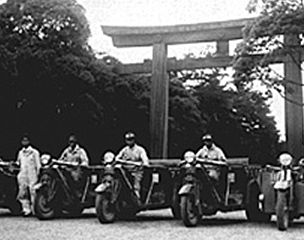Mazda's history as an automaker began in 1931 with the unveiling of a three-wheeled truck known as the Mazda-Go Type-DA. The company was aiming for class-leading performance and maximum loading capacity, domestic production of various parts including the engine, and the setting up of a consistent volume production system. The engine was built in-house and had a transmission with a reverse gear, a rear differential and other components patented by Mazda(then Toyo Kogyo). The introduction of the Mazda-Go was a pivotal moment in the history of Japan's three-wheeled truck market.
Japan's automotive history began with Mitsubishi Shipbuilding, Ltd. (currently Mitsubishi Motors) which commenced production of its Mitsubishi A Type passenger car in 1917. Nissan, in its previous form was established as an automaker in 1933, Toyoda Automatic Loom Works, Ltd. (currently Toyota) completed its A1 Type passenger car in 1935, and Honda was established later in 1946. In this historical context, Mazda was an early starter in automobile manufacturing compared with other Japanese companies.





